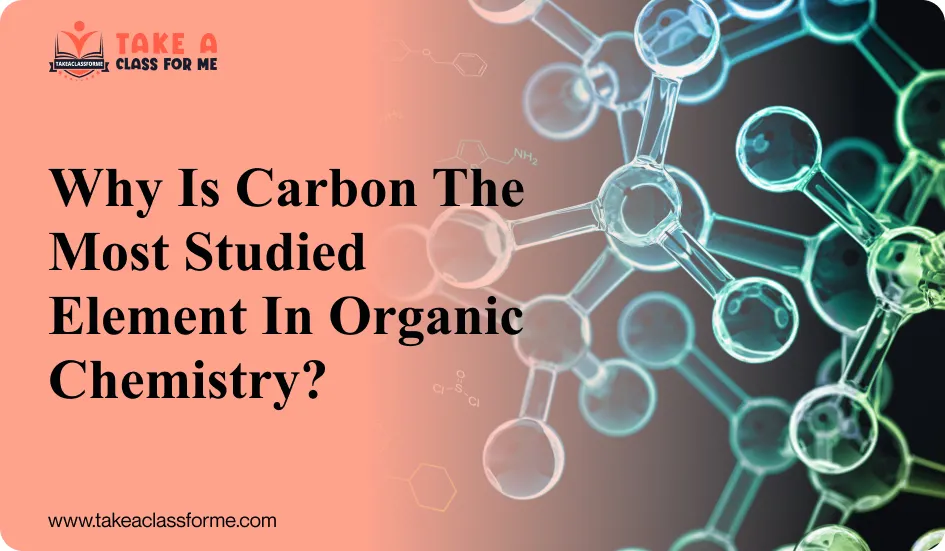
Organic chemistry focuses on the structure and properties of carbon-containing compounds. But ever wondered? Why is it only carbon? Let us tell you. Carbon has unique properties of forming covalent bonds with other carbons and elements.
With its exceptional quality of tetra valency and presence in almost every reaction, carbon is the center of organic chemistry. From the DNA present in your cells to the toothbrushes you use in daily life, carbon is found to be everywhere! Let’s take a detailed look at Why is carbon the most studied element in organic chemistry.
What is Organic Chemistry?
Carbon forms thousands of different bonds with different elements to produce new products. An example of these bonds is carbon binding with hydrogen through a single bond to produce CH4, also known as methane or two carbons binding with hydrogen to produce ethane C2H6 or three carbons binding together with eight hydrogens to produce propane C3H8.
From basic compounds like ethane which are found in detergents to complex ones like carbohydrates and nucleic acids which are the base of your body, organic chemistry involves studying the structure, function, and characteristics of these compounds.
With the diverse role of carbon in organic compounds, let’s explore more about it.
The Unique Properties of Carbon
Being the 4th most available element on earth and also found beyond the earth in stars and sun, let’s take a look at Carbon’s unique properties in chemistry that have made it the king of elements.
Carbon’s ability to form four covalent bonds (tetra-valency)
So what is this special quality that makes carbon form four bonds? It is its unique ability known as its tetravalency. Carbon has the atomic number 6, which indicates a total of 6 electrons. 2 of these electrons are present inside and 4 of these electrons are present in the outer structure ready to bind with other atoms.
So whenever these electrons approach any atom that has electrons present, carbon forms a bond with these atoms.
Consider an example of methane. (CH4)
A carbon atom forms bonds with four hydrogens, this means each of its four electrons are bonded with the four H atoms.
These bonds are not only restricted to hydrogen, instead, carbon combines with other elements such as oxygen, nitrogen, and sulfur as well.
The Small Size of Carbon Atoms and its Impact on Bond Formation.
As compared to other elements such as Silicone, Carbon with its smaller size, comes with an extra advantage of strong and flexible bond formation.
The valence electrons of the carbon are fewer and near to the positively charged nucleus forming strong covalent bonds, whenever carbon bonding in organic molecules occurs.
Carbon’s versatility in forming single, double, and triple bonds.
The importance of carbon in organic chemistry also comes from its versatility to form not only single but also double and triple bonds.
These elements consisting of various bonds have several different physical as well as chemical characteristics.
Single bond: Single covalent bonds are where a carbon forms only one bond with other elements. These bonds are weak but more stable than other bonds. Whenever you see a single line between elements, you can instantly understand that it is a single bond!
Some of the examples are:
- Methane (CH4) One carbon forms a bond with four hydrogen atoms.
- Ethane( C2H6) Two carbons forming a single bond with three hydrogens each.
- Propane (C3H8) Three carbons forming a single bond with three hydrogens each.
Double bond: Compounds forming double bonds are more reactive than single bonds as they are more strong and display points of reactivity. Planar structures demonstrate double bonds.
Some examples of these are:
- Ethene (C2H4)
- Propene(C3H6)
Triple bonds: When a total of six electrons are shared, ( 3 electrons from 2 carbons) a triple bond is formed. These triple bonds are the strongest of all.
Examples of these are:
- Ethyne (C2H2)
- Propyne (C3H4)
Importance of Carbon’s Ability to Form Chains, Rings, and Complex Structures
Carbon bonding in organic molecules doesn’t only involve straight chains but the production of diverse rings as well as complex structures.
Through a process known as catenation, carbon forms unlimited branches and keeps on bonding with different elements to give rise to complex structures. Catenation is commonly seen among carbon but other elements such as silicone and nitrogen also perform it.
Chains: A chain consists of no more than three hydrogen atoms bound with carbon. These chains are either branched, linear, or cyclic. These chains are characteristically nonpolar.
Examples of hydrocarbon chains are.
- Methane
- Ethane
- Propane
Rings: Instead of long chains, these cyclic structures close as rings.
Example: Benzene (C6H6)
Complex structures: These structures are three-dimensional shapes formed by the combination of chains and rings.
Essential macromolecules of our lives are some examples such as proteins, lipids, and carbohydrates which are polymers formed from monomers of amino acids, triglycerides, and sugars, respectively.
Why Carbon is Central to Organic Chemistry
Organic chemistry and carbon are interconnected due to carbon’s unparalleled capacity to bond with other elements, including hydrogen, oxygen, nitrogen, and sulfur. Depending on the electronegativity, carbon forms various bonds such as ionic and covalent with these other elements.
From the wide variety of organic molecules formed by Carbon, a few examples of how carbon forms the backbone of biomolecules are:
- Carbohydrates: Carbohydrates are made up of oligosaccharide monomers and the backbone of this biomolecule is carbon, oxygen, and hydrogen.
- They are the source of energy your body needs to function every day.
- Lipids: Lipids have the same backbone made as carbohydrates including carbon, oxygen, and hydrogen. Making the cell membrane, saving energy in the form of fat, and controlling hormones are some of the functions of lipids.
- Proteins: Proteins are made up of amino acid monomers. Their backbone is formed by carbon, hydrogen, nitrogen, oxygen, and sulfur. They are responsible for growth, maintain the pH, and act as antibodies.
- Nucleic acids: Carbon, hydrogen, nitrogen, oxygen, and phosphorus form their backbone. They comprise DNA and RNA, responsible for genetic information.
These biomolecules are organic which means they necessarily have carbon present in them. A strong covalent bond between these monomers from carbon-carbon bonding is what makes them capable of performing the functions of your body.
Carbon’s Role in the Diversity of Organic Compounds
Carbon has more than 10 million organic compounds. Each compound has its characteristics and this diversity comes from carbons ability to form different types of bonds with other elements.
Carbon’s bonding versatility leads to a wide array of functional groups. Functional groups are groups of molecules attached to elements in such a way that they possess the same qualities.
Carbon binds with other atoms such as oxygen, hydrogen, and nitrogen to form functional groups. These functional groups ensure that atoms within a molecule act in similar ways. The vast number of organic compounds may have similar functional groups present making them a family, let’s take a look at a few of these:
- Hydroxyl Group: This group is denoted by OH and is found in alcohols. Alcohols have characteristics such as high boiling points and polar nature. From beverages to acting as preservatives for specimens, alcohols have a wide use in our daily lives.
- Carbonyl Group: Aldeygydes and Ketones contain this group. Their use is spread out in the manufacturing of cosmetics, nail paint removers, and synthesizing medicines.
- Carboxylic Group: They contain carboxylic acids, an example is the synthetic vinegar lying in your kitchen cabinet, also known as acetic acid. They are characterized as weak acids with high boiling points.
- Esters: Formed from esterification reactions which involve the addition of carboxylic acid and alcohol. Whereas the carboxylic group produces sour vinegar, esters have a delightful fragrance and are used as perfumes and added flavors.
This list continues with a few more functional groups, and these structures and concepts are often confusing to students and they struggle with organic chemistry and carbon-related concepts.
In this case, you can look for options like ‘’Pay someone to take my online chemistry class’’.
Examples of Carbon-Based Compounds in Organic Chemistry
Carbon bonding in organic molecules has resulted in generating numerous compounds. Organic chemistry comprises a detailed study of basic to intricate compounds. Let’s explore some of the most common organic molecules and their significance in our everyday lives.
Methane (CH4):
To start with the most basic hydrocarbon, we can consider methane. Methane has the chemical formula CH4, which indicates one carbon atom is bound to four hydrogen atoms. To picture this you can consider a lonely C surrounded by four H atoms.
It’s a gas with no odor. Methane is widely spread from tiny areas such as the guts of termites where bacterial decomposition occurs to digestion in the fishes present in the oceans, or deposits are also found in volcanos whereas the natural gas that lights up on your stoves also constitutes about 90% of methane.
- Methane plays a huge role in the creation of organic molecules that contribute to the process of creating essential products such as methane, ammonia is derived which assists in the production of fertilizers, making the lives of farmers convenient.
- Methane is also responsible for the production of materials that stabilize your car tires.
Ethylene(C2H4)
Ethylene is made when carbon-carbon forms double bonds with four hydrogens. These double bonds ensure a firm structure is formed. Unlike other odorless gases, ethylene is a sweet-flavored compound.
Uses of ethylene include:
- You might have heard about human hormones, but let us tell you that plants also consist of hormones. Shocking, right?
One of these hormones is Ethylene! Ethylene contributes to various growth phases of plants such as pollination, seed germination, controlling the elongation of stems, and ripening of the fruits.
- The production of polyethylene commonly known as plastics is done by ethylene as well.
Acetylene(C2H2)
Acetylene has two carbons bound by triple bonds and two hydrogen atoms attached to them.
Acetylene can be found through bacterial decompositions in water, and natural gases and oils. The extremely high temperature generated by acetylene flames makes them capable of being used in the welding industry, and they also serve as a medium for the production of plastics.
Let’s take a look at real-life examples of carbon compounds in medicine, industry, and biology and how the materials you carry in your hands are composed of organic molecules.
Vinegar (Ethanoic Acid)
When acetic acid is diluted, vinegar is formed. The chemical formula for vinegar is CH3COOH, which denotes that two carbons make a bond with each other. One carbon binds with three hydrogen atoms and one carbon binds with a hydroxyl and oxygen group.
The role of vinegar:
- Acts as a flavor enhancer but is not only limited to kitchen crockery.
- With its remarkable acidic properties, vinegar can be used as a cleaning agent. So all those greasy stoves can be shined by vinegar as well!
- Acts as a disinfectant.
- Kills insects, so just spray distilled vinegar on the area where you are exhausted with ants.
- Can be included in shampoos to provide shine to hair.
Aspirin (Acetylsalicylic Acid)
As we discussed above regarding ring structures, here comes the example! Aspirin structure contains a cyclic ring with two functional groups attached: an ester(COOR) and a carboxylic acid(COOH).
Along every household, the medicine box contains a strip of aspirin for sure!
Its wide services for the human body include:
- Antiinflammatory properties.
- It blocks cyclooxygenases which produce prostaglandins.
- Assist in healthy cardiovascular conditions by preventing the formation of clots.
- Consuming aspirin is also seen as effective in case of headaches.
- Aspirin also contributes to decreasing the probability of cancer occurrence.
Conclusion
In conclusion, carbon is an extraordinary element with its divine characteristics in the world of elements.
From its tetravalency, which makes it electron bonding friendly, to its small size, which makes these bonds rigid, to its capability of dividing these bonds further into single, double, and triple, carbon’s versatility, all of these carbon’s unique properties in chemistry are what makes it a special element capable of forming plenty of organic molecules with their exceptional characteristics.
Products such as methane making the lives of farmers easier, acetylene with its wide industrial uses, vinegar with its unlimited benefits for us to create DIY hacks, and aspirin produced in the medicine industry, which contributes to health, are all available because of carbon.
On a molecular level, complex structures like cholesterol form our cell membrane and glucose provides energy for our metabolic reactions. Carbon is a significant element responsible for these functions, and delving deeper into organic chemistry will present you with even more of its roles. Studying organic chemistry requires a lot of time due to intricate structures, reactions, and their functions. If you are struggling with an unbalanced routine, consider services like “Take A Class For Me”.
Expert Assignment Writer
Hi everyone! Hello there, My name is Emily, and I provide Online Class Helper services in Los Angeles. Who says balancing between work or school by meeting and final tasks, and having a busy social life? I discovered “Take A Class For Me” when I couldn’t effectively manage the rigors of an online business management class. They were so helpful with our online class whether it be with tutorials or assignment submissions. I can now devote time and energy to a job, but I do not have to sacrifice academic performance for it.






